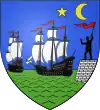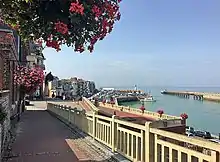Le Tréport
Le Tréport (French pronunciation: [lə tʁepɔʁ]) is a commune in the Seine-Maritime department in Normandy, France.
Le Tréport | |
|---|---|
 A general view of Le Tréport | |
 Coat of arms | |
Location of Le Tréport | |
 Le Tréport  Le Tréport | |
| Coordinates: 50°04′N 1°22′E | |
| Country | France |
| Region | Normandy |
| Department | Seine-Maritime |
| Arrondissement | Dieppe |
| Canton | Eu |
| Intercommunality | CC Villes Sœurs |
| Government | |
| • Mayor (2020–2026) | Laurent Jacques[1] (PCF) |
| Area 1 | 6.77 km2 (2.61 sq mi) |
| Population | 4,441 |
| • Density | 660/km2 (1,700/sq mi) |
| Time zone | UTC+01:00 (CET) |
| • Summer (DST) | UTC+02:00 (CEST) |
| INSEE/Postal code | 76711 /76470 |
| Elevation | 0–103 m (0–338 ft) (avg. 20 m or 66 ft) |
| 1 French Land Register data, which excludes lakes, ponds, glaciers > 1 km2 (0.386 sq mi or 247 acres) and river estuaries. | |
Geography


A small fishing port and light industrial town situated in the Pays de Caux, some 21 miles (34 km) northeast of Dieppe at the junction of the D 940, the D 78 and the D 1015 roads. The mouth of the river Bresle meets the English Channel here, in between the high (110 metres or 360 feet) chalk cliffs and the pebbly beach. Le Tréport-Mers station has rail connections to Beauvais. Le Tréport is also a sea-side resort and home to a casino.
History
Le Tréport (the ancient Ulterior Portus) was a port of some note in the Middle Ages and suffered from the English invasions.[3] Louis Philippe I twice received Queen Victoria here[3] in 1843[4] and 1845.[5]
The casino was built in 1896–1897.[3]
The British World War I soldier Arthur Bullock, who was stationed in Le Tréport after the Armistice, was captivated by the town, nestling at the bottom of cliffs which could be ascended by 365 steps or by a cliff railway. Bullock recorded in his memoir, 'The sea floor must have been covered by multicoloured sands, for on a clear day, looking from the cliffs straight down into the sea, it seemed that one was looking at a vast abstract canvas of blues, yellows, reds and greens'. While staying there, Bullock also painted a study of a French fisher girl with a basket on her back.[6]
In World War II the town was liberated by the 3rd Canadian Division on 1 September 1944.[7]
The city was powered by an electric tramway from 1902. The operation of the Eu-Le Tréport-Mers tramway ceased in 1934.
The vocation of Le Tréport as a seaside resort began under the reign of Louis-Philippe, when the family of this sovereign, residing regularly in Eu, inaugurated the fashion for sea bathing. The Parisian upper middle class wasted no time in building villas on the waterfront and led a social life there until the eve of the Second World War. The tramway was installed at this time as a corollary.
The Tréport - Mers railway station, opened on May 12, 1872, gave Parisians access to the seaside resort and stirred its development. One saw travelers getting off a pleasure train, before the First World War.
Most of the villas were destroyed during the military operations of 1944, which explains the presence of typical 'reconstruction architecture, particularly by the sea.
A college in Tréport has the name of Rachel-Salmona, in memory of a 10-year-old girl deported in February 1943, suffering the fate of her father Vitali a few months later, in the Auschwitz camp with her sister, her mother and his grandmother, after being interned in Dieppe and the Drancy camp.
The German army fearing during the whole of the Second World War a landing in Normandy, had several galleries drilled into the cliff to build defenses there facing the sea. These galleries, the whole of which bears the name of Kahl-Burg, are accessible and can be visited today.
Peace and reconstruction brought a comeback of popular tourism and beach life.
An oyster bed, where one could taste the seafood at the very exit of the basins, was located at the very end of the pier, just below the cliffs, after the funicular. A picturesque and popular place, the oyster bed closed its doors in the 1970s.
Population


| Year | Pop. | ±% p.a. |
|---|---|---|
| 1968 | 6,328 | — |
| 1975 | 6,816 | +1.07% |
| 1982 | 6,455 | −0.77% |
| 1990 | 6,227 | −0.45% |
| 1999 | 5,900 | −0.60% |
| 2007 | 5,728 | −0.37% |
| 2012 | 5,217 | −1.85% |
| 2017 | 4,870 | −1.37% |
| Source: INSEE[8] | ||
Administration
The current mayor of Le Tréport is Laurent Jacques of the PCF political party. He became 1st vice-mayor following the 2014 municipal elections (2014-2020). He took over as mayor in January 2016 upon the death of his predecessor Alain Longuent (PCF).
Main sights

- The remains of an eleventh-century abbey
- The chapel of St. Julien
- The lighthouse
- The new funicular, built in 1907-08, and restored in 2006,[9] linking the town with the cliff-tops
- The church of St. Jacques du Tréport, dating from the fourteenth century
- Two museums (the Vieux Tréport museum and the local history museum)
People
Paul Paray, conductor, was born here in 1886.
Miscellaneous
The three towns of Le Tréport, Eu and Mers-les-Bains are known locally as the three sisters.
Television
Le Tréport was used as the location for the 2014 French police thriller Witnesses ("Les témoins"). The series, which was written by Hervé Hadmar and Marc Herpoux, starred Thierry Lhermitte and Marie Dompnier. Its style and tempo have been compared to Scandinavian noir such as Wallander, The Bridge and The Killing.
It formed the background for François Ozon's 2020 film Summer of 85.[10]
References
- "Répertoire national des élus: les maires". data.gouv.fr, Plateforme ouverte des données publiques françaises (in French). 2 December 2020.
- "Populations légales 2020". The National Institute of Statistics and Economic Studies. 29 December 2022.
- Chisholm, Hugh, ed. (1911). . Encyclopædia Britannica. Vol. 16 (11th ed.). Cambridge University Press. p. 500.
- "Royal visit to Louis-Philippe: arrival of Queen Victoria at Le Tréport, 2 September 1843". Royal Collection Trust. Retrieved 2020-10-21.
- "Meeting between Louis-Philippe I and Queen Victoria at Le Treport 2 September 1845". Retrieved 2020-10-21.
- Bullock, A S, Gloucestershire Between the Wars: A Memoir, The History Press, 2009, pages 94-95
- "The Campaign in North-West Europe: The Channel Ports, September 1944". The Canadian Army, 1939–1945. Department of National Defence. p. 224. Archived from the original on 2010-07-06. Retrieved 21 Nov 2020.
- Population en historique depuis 1968, INSEE
- "Take the funicular railway in Le Tréport and enjoy the view - Seine Maritime Tourism". Seine-maritime-tourisme.com. Retrieved 2017-05-04.
- critic, Mark Kermode Observer film (2020-10-25). "Summer of 85 review – François Ozon's bittersweet teen romance". The Guardian. ISSN 0261-3077. Retrieved 2020-10-26.